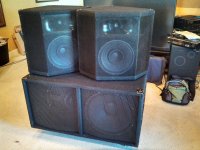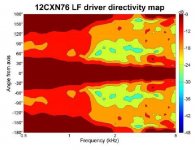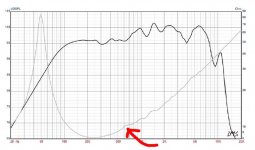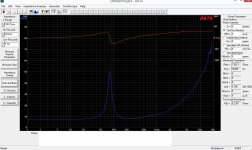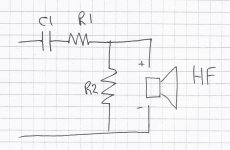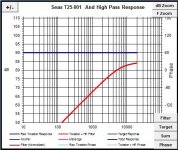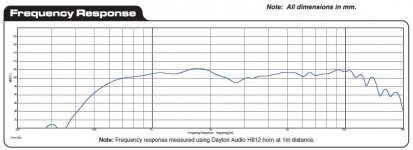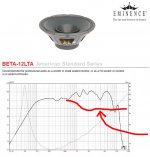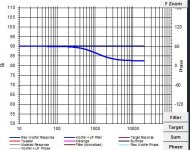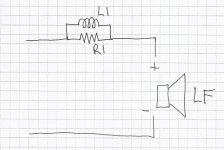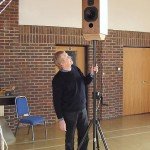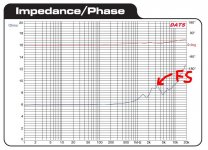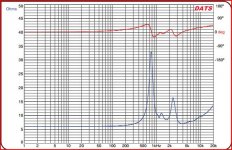Compression driver selection & Revision
I recently completed my second pro class speaker build--Version 1.0, anyway.
The drivers I selected for this "two-way" are the Eminence Beta-12LTA and the Dayton Audio D250P-8. I chose the Denovo SEOS-12 Waveguide.
I was attracted to the Beta-12LTA for it's point-source nature, and consequentially extended high frequency response. My expectation of the driver has been surpassed--I am extremely pleased with my selection. My dissatisfaction and subject of this thread comes from the compression driver.
My design goal was to create a two-way speaker with an extended range or full range piston driver to keep the crossover out of the sensitive vocal range as much as possible, 3k or above. The Beta-12LTA promised this, and fulfilled it's promise.
The only active crossover I own right now is an iNuke1000DSP amp, which I realize is not the most ideal thing to use. Combined with considerable time listening to different crossover points and slopes, I concluded these speakers sound best when the Beta-12LTA is run full range, implementing a first order high pass on the tweeter at 4kHz. There is a dip in this range on the LTA according to the manufacturers stated frequency response. I have not done any measurements myself. I plan to in the future, I have not found time to clean out the basement for suitable set up room.
The iNuke amp is not audiophile grade by any stretch of the imagination, so I had to get away from it. Because the best crossover I could determine was so simple, I switched to passive implementing Jantzen silver z-caps and moved to a much better sounding amp. These upgrades improved the sound phenomenally. It was actually at this point I realized my suspicion was true--The D250P-8 is not cutting it.
I can not get the Dayton D250P-8 to sound acceptably enough. I don't want to mislead anyone considering the purchase of a D250P-8. Don't get me wrong, these speakers rock (literally) the way they are now. However, according to what is my opinion, the D250P-8 can not keep up with the LTA in terms of fidelity.
In my dissatisfaction, I turned to my pair of Bohlender Graebener Neo3-PDRW isodynamic planer tweeters, which are currently open-back. I understand an open-back planer tweeter is pretty far removed from a horn loaded compression driver, but I knew the Neo3 had the clarity I was looking for, and I wanted to confirm my crossover decision was good. (Most notably wanting to confirm a passive xo could sound good.) Turning the cabs upside-down for minimum driver distance, I sat the Neo3s on top and wired them passively with Jantzen Superior-Z caps. (Different Z so I had to use different capacitors, I already owned the Superior-Z and they coincidentally fell exactly on the 4kHz mark! I should note I used a simple online crossover calculator for this and not an actual speaker designer spreadsheet. I felt this method would suffice due to the simplicity.)
The level of the tweeter needed attenuation, but otherwise perfect match! The LTA actually blended with the Neo3s so well I haven't yet put the effort towards attenuating the Neo3s. It's so close, and it sounds sooo very good. So this is where I am now, I would like to find a compression driver with great clarity. I don't want to spend $800 per driver, however. I found the B&C DE250-8 which looks interesting.
Attached is an image of the two speakers sitting on their accompanying sub. The baffles have 45 degree faceplates to reduce diffraction. This, combined with a high frequency crossover, allows the Beta-12LTA to be spectacular in it's job of reproducing vocals, which was my goal. Vocal clarity is phenomenal!
Any advice? Thanks for reading!
I recently completed my second pro class speaker build--Version 1.0, anyway.
The drivers I selected for this "two-way" are the Eminence Beta-12LTA and the Dayton Audio D250P-8. I chose the Denovo SEOS-12 Waveguide.
I was attracted to the Beta-12LTA for it's point-source nature, and consequentially extended high frequency response. My expectation of the driver has been surpassed--I am extremely pleased with my selection. My dissatisfaction and subject of this thread comes from the compression driver.
My design goal was to create a two-way speaker with an extended range or full range piston driver to keep the crossover out of the sensitive vocal range as much as possible, 3k or above. The Beta-12LTA promised this, and fulfilled it's promise.
The only active crossover I own right now is an iNuke1000DSP amp, which I realize is not the most ideal thing to use. Combined with considerable time listening to different crossover points and slopes, I concluded these speakers sound best when the Beta-12LTA is run full range, implementing a first order high pass on the tweeter at 4kHz. There is a dip in this range on the LTA according to the manufacturers stated frequency response. I have not done any measurements myself. I plan to in the future, I have not found time to clean out the basement for suitable set up room.
The iNuke amp is not audiophile grade by any stretch of the imagination, so I had to get away from it. Because the best crossover I could determine was so simple, I switched to passive implementing Jantzen silver z-caps and moved to a much better sounding amp. These upgrades improved the sound phenomenally. It was actually at this point I realized my suspicion was true--The D250P-8 is not cutting it.
I can not get the Dayton D250P-8 to sound acceptably enough. I don't want to mislead anyone considering the purchase of a D250P-8. Don't get me wrong, these speakers rock (literally) the way they are now. However, according to what is my opinion, the D250P-8 can not keep up with the LTA in terms of fidelity.
In my dissatisfaction, I turned to my pair of Bohlender Graebener Neo3-PDRW isodynamic planer tweeters, which are currently open-back. I understand an open-back planer tweeter is pretty far removed from a horn loaded compression driver, but I knew the Neo3 had the clarity I was looking for, and I wanted to confirm my crossover decision was good. (Most notably wanting to confirm a passive xo could sound good.) Turning the cabs upside-down for minimum driver distance, I sat the Neo3s on top and wired them passively with Jantzen Superior-Z caps. (Different Z so I had to use different capacitors, I already owned the Superior-Z and they coincidentally fell exactly on the 4kHz mark! I should note I used a simple online crossover calculator for this and not an actual speaker designer spreadsheet. I felt this method would suffice due to the simplicity.)
The level of the tweeter needed attenuation, but otherwise perfect match! The LTA actually blended with the Neo3s so well I haven't yet put the effort towards attenuating the Neo3s. It's so close, and it sounds sooo very good. So this is where I am now, I would like to find a compression driver with great clarity. I don't want to spend $800 per driver, however. I found the B&C DE250-8 which looks interesting.
Attached is an image of the two speakers sitting on their accompanying sub. The baffles have 45 degree faceplates to reduce diffraction. This, combined with a high frequency crossover, allows the Beta-12LTA to be spectacular in it's job of reproducing vocals, which was my goal. Vocal clarity is phenomenal!
Any advice? Thanks for reading!
Attachments
Last edited:
I've used the B&C DE120 extensively and it's very open and detailed sounding. The only problem I see with your design is that when choosing a crossover point you need to pick a spot where the LF and HF have approximately the same coverage pattern. The Beta 12LTA will beam considerably because it's such a large diameter driver. I don't see any polar charts on the eminence website. I've attached a typical polar plot of at 12" woofer. You can see it seriously starts to beam at 2kHz and is down -6dB only 15 degrees off axis. The SEOS-12 horn appears to be a nominal horizontal coverage pattern of 90 degrees creating a large mismatch in coverage.
Also, I always try to avoid running the LF past where the driver starts having modes. You can tell this driver is starting to breakup as low as 600hz by looking at the irregularities in the impedance curve. (see also attached).
Cone breakup will add to the beaming effect, and also limit it's power handling.
My advice would be eliminate the horn from your cabinet and place a larger horn on top of the cabinet, or build a second enclosure for the horn and crossover.
For the Beta 12LTA I'd be looking at cutting it off at 1.5 kHz and using a B&C DE250 with the ME20 horn. The midrange/vocal clarity of the B&C will exceed that of the Beta 12LTA so don't worry about that.
Hope this helps.
Also, I always try to avoid running the LF past where the driver starts having modes. You can tell this driver is starting to breakup as low as 600hz by looking at the irregularities in the impedance curve. (see also attached).
Cone breakup will add to the beaming effect, and also limit it's power handling.
My advice would be eliminate the horn from your cabinet and place a larger horn on top of the cabinet, or build a second enclosure for the horn and crossover.
For the Beta 12LTA I'd be looking at cutting it off at 1.5 kHz and using a B&C DE250 with the ME20 horn. The midrange/vocal clarity of the B&C will exceed that of the Beta 12LTA so don't worry about that.
Hope this helps.
Attachments
The only problem I see with your design is that when choosing a crossover point you need to pick a spot where the LF and HF have approximately the same coverage pattern.
I'd agree with that if the OP was building a speaker for PA applications, if however it's for home listening and the only seat that matters is in the sweet spot then system coverage can take a back seat. Compression drivers are not all created equal too, I have a collection here that in terms of sound quality range from god-awful to stunning with another B&C being at the top of that list, but of course it's also the most expensive driver I own.
It's good to hear positive feedback about the B&C brand, I will consider the DE120 as well. The DE250 seems to have more power handling, which is important. Which B&C driver do you own, conanski?
My bad for leaving out intended usage. These actually will be used as PA speakers. I DJ weddings, so I wanted to create something simple and sleek looking. I have yet to use them on the job, but I have taken them to a bridal show. I received positive feedback from brides about their look. I think they look better in person than in that picture. My smartphone camera could not capture the black levels perfectly. The sub looks slightly purple in that picture even, which it is not. Lol.
I measured the impedance curve on one of my Beta-12LTA drivers with my DATS. I did not measure in free air, rather left it in the enclosure. To my surprise, the entire impedance and phase lines were jagged throughout. They were not consistently jagged, however. I measured a dozen times in a row, and the jaggedness of the lines were almost never close to identical. Sometimes the impedance would do crazy things near 20kHz like spike higher than normal, or jump erratically. Does this mean it has break up modes throughout the entire frequency spectrum? Does this mean I don't have to worry about below 600Hz anymore--Rather every frequency?
Thank you for the observation of the importance of coverage pattern. I had never previously been instructed to pay attention to it, but I suppose most assume as conanski pointed out, it doesn't matter as much with home listening. I have a few observations, but I am still learning, so please bear with me.
You referenced a normal 12" driver, but I would like to point out this Beta-LTA is not a normal 12" driver. It has a whizzer cone. To my understanding, this smaller cone improves high frequency dispersion , although I will admit to not knowing how well.
I have to say, I trust my ears a lot. I spent a lot of time playing around with crossover configurations. As you stated, a lower point should sound clearer. I did observe this; I found a lower point with a steeper slope on both the LTA and the CD produced "clearer" sound. However, it did not sound better that way. Strangely, vocal inteligability was actually lower. When I finally settled on running the LTA full range and the CD xo at 4kHz with a first order slope, it was the best compromise of everything. It sounds the best that way. Also, because I am using such a shallow slope, it sounds to my ears as if the tweeters are still filling in their share in the 2kHz region. But heck, I'm still learning, and I'm happy to receive correction.
Building something on top is out of the question. These speakers are built to look sleek; their looks are more important than their sound because of this application. I do however, have the ability to replace the horn by modifying the cabinet. I'm not yet convinced I need to, however. In my mind, whizzer cone + shallow xo = close enough. Is that so totally wrong?
My bad for leaving out intended usage. These actually will be used as PA speakers. I DJ weddings, so I wanted to create something simple and sleek looking. I have yet to use them on the job, but I have taken them to a bridal show. I received positive feedback from brides about their look. I think they look better in person than in that picture. My smartphone camera could not capture the black levels perfectly. The sub looks slightly purple in that picture even, which it is not. Lol.
I measured the impedance curve on one of my Beta-12LTA drivers with my DATS. I did not measure in free air, rather left it in the enclosure. To my surprise, the entire impedance and phase lines were jagged throughout. They were not consistently jagged, however. I measured a dozen times in a row, and the jaggedness of the lines were almost never close to identical. Sometimes the impedance would do crazy things near 20kHz like spike higher than normal, or jump erratically. Does this mean it has break up modes throughout the entire frequency spectrum? Does this mean I don't have to worry about below 600Hz anymore--Rather every frequency?
Thank you for the observation of the importance of coverage pattern. I had never previously been instructed to pay attention to it, but I suppose most assume as conanski pointed out, it doesn't matter as much with home listening. I have a few observations, but I am still learning, so please bear with me.
You referenced a normal 12" driver, but I would like to point out this Beta-LTA is not a normal 12" driver. It has a whizzer cone. To my understanding, this smaller cone improves high frequency dispersion , although I will admit to not knowing how well.
I have to say, I trust my ears a lot. I spent a lot of time playing around with crossover configurations. As you stated, a lower point should sound clearer. I did observe this; I found a lower point with a steeper slope on both the LTA and the CD produced "clearer" sound. However, it did not sound better that way. Strangely, vocal inteligability was actually lower. When I finally settled on running the LTA full range and the CD xo at 4kHz with a first order slope, it was the best compromise of everything. It sounds the best that way. Also, because I am using such a shallow slope, it sounds to my ears as if the tweeters are still filling in their share in the 2kHz region. But heck, I'm still learning, and I'm happy to receive correction.
Building something on top is out of the question. These speakers are built to look sleek; their looks are more important than their sound because of this application. I do however, have the ability to replace the horn by modifying the cabinet. I'm not yet convinced I need to, however. In my mind, whizzer cone + shallow xo = close enough. Is that so totally wrong?
A few additional notes:
I found the speakers sounded more pleasant listening with the horns and CD at close to a 90 degree angle from the back wall perpendicular to the listening position. With the Neo3s, the same listening angle achieved similar results, but the speakers could be turned to approximately 43 degrees with no penalty to "pleasantness" and a substantial increase in sound stage, which otherwise was never as strong with the horn at any angle.
The enclosure walls are all an inch and a quarter thick, consisting of 3/4 birch plywood on the outside, and 1/2 MDF on the inside. There is oak bracing running from the front of the baffle to the back corner. All of the corners as well as gaps created by the steel handles are filled in and sealed with Bondo. This thing is a tank.
I found the speakers sounded more pleasant listening with the horns and CD at close to a 90 degree angle from the back wall perpendicular to the listening position. With the Neo3s, the same listening angle achieved similar results, but the speakers could be turned to approximately 43 degrees with no penalty to "pleasantness" and a substantial increase in sound stage, which otherwise was never as strong with the horn at any angle.
The enclosure walls are all an inch and a quarter thick, consisting of 3/4 birch plywood on the outside, and 1/2 MDF on the inside. There is oak bracing running from the front of the baffle to the back corner. All of the corners as well as gaps created by the steel handles are filled in and sealed with Bondo. This thing is a tank.
Waited too long to edit. Here is a measured in-box example.
A first order crossover at 4 kHz is actually what I ended up going with on my design, very similar to yours, however the woofers I'm using is a Fostex FF165WK which is a 6.5" with an aluminum dust cap. The dust cap serves to extend the high frequency identical to a whizzer cone. I ended up using two in a MTM design. I'm sure we're talking about a very similar sound here.
It's good that you used Baltic Birch in your design, and even better having the MDF inside as well, and to boot you've made it trapezoidal to reduce internal standing waves. I recommend getting the Dayton UMM-6 reference measurement mic. It connects directly to a PC via USB. I use a free program called Holm Impulse to do Gated frequency response plots (quasi anechoic). It's helped me tremendously to design my own passive crossovers. I even used it to time align my drivers.
Another thing you might try is to tilt the upper frequencies by building the following passive crossover.
R1=3 ohm
R2=6 ohm
It will give you the curve shown below, with the highs tilted upwards, this compensates for the weakening highs found in most compression drivers.
Experiment with different values. Increase the difference between the to resistors to give a more aggressive tilt. To add attenuation increase R1 and decrease R2.
This may not be 'by the book' but is simply something I discovered using a program called 'Passive Crossover Designer 7'.
Attachments
Last edited:
Also, I would add a passive filter on the BETA-12LTA to shelf down the highs.
L1=1.5 mH
R1=22 ohm
Give that a try. I did this and it substantially increased the amount of bass (which I like!)
Your system efficiency will drop, but to me it provided a much more rounded sound that is much fuller.
L1=1.5 mH
R1=22 ohm
Give that a try. I did this and it substantially increased the amount of bass (which I like!)
Your system efficiency will drop, but to me it provided a much more rounded sound that is much fuller.
Attachments
I'm getting more exited about this project! I used Passive Crossover Designer 7 extensively in my first pro class speaker build. Back then I didn't have the measurement and calibration tools I do now, so I could only do so much.
I own the Dayton Audio OmniMic V2 Precision Measurement System. The microphone looks identical to the UMM-6, save color. Is it correct to assume it can perform the same functions? I recently purchased the OmniMic V2 for this very project, but have actually yet to use it due to aforementioned basement obstacles. What kind of environment do you test in Joseph? I was going to go all out and create wooden frame panels to hang from the ceiling made from fiberglass and studio foam.
I think I'll go ahead and place an order for the parts in the values you suggested, probably throwing in a dozen extra resistors or so. Thanks!
I had already made previous arrangements to use these speakers gigging a small band for the first time later today. We will see how that goes, I'll post my observations.
-David Strunk
I own the Dayton Audio OmniMic V2 Precision Measurement System. The microphone looks identical to the UMM-6, save color. Is it correct to assume it can perform the same functions? I recently purchased the OmniMic V2 for this very project, but have actually yet to use it due to aforementioned basement obstacles. What kind of environment do you test in Joseph? I was going to go all out and create wooden frame panels to hang from the ceiling made from fiberglass and studio foam.
I think I'll go ahead and place an order for the parts in the values you suggested, probably throwing in a dozen extra resistors or so. Thanks!
I had already made previous arrangements to use these speakers gigging a small band for the first time later today. We will see how that goes, I'll post my observations.
-David Strunk
Last edited:
I'm getting more exited about this project! I used Passive Crossover Designer 7 extensively in my first pro class speaker build. Back then I didn't have the measurement and calibration tools I do now, so I could only do so much.
I own the Dayton Audio OmniMic V2 Precision Measurement System. The microphone looks identical to the UMM-6, save color. Is it correct to assume it can perform the same functions? I recently purchased the OmniMic V2 for this very project, but have actually yet to use it due to aforementioned basement obstacles. What kind of environment do you test in Joseph? I was going to go all out and create wooden frame panels to hang from the ceiling made from fiberglass and studio foam.
I think I'll go ahead and place an order for the parts in the values you suggested, probably throwing in a dozen extra resistors or so. Thanks!
I had already made previous arrangements to use these speakers gigging a small band for the first time later today. We will see how that goes, I'll post my observations.
-David Strunk
The mic looks identical to what I have, yours is the complete kit. I cheaped out got just the mic! As far as fiberglass and studio foam you don't need any of that. The concept of a gated response is to mute (or gate) the sound right after the emitted sound from the speaker reaches the mic. The software (holmimpulse) will do this automatically. This causes the room reflections (which arrive at the mic later) to be excluded from the measurement results. In effect you get the same results as if you had a anechoic chamber. The only caveat is that it is only effective past a certain frequency, say 800 hz for example, and is dictated by the size or your room. Holmimpulse has an arrow on the graph telling you what frequency it was able to achieve for your gated response.
I measure in my basement and I move everything away as far as possible and place the speaker in the middle on a stand. Vertically it is positioned approximately in the middle between the floor and ceiling. The mic distance has to be two times the largest dimension of your speaker. If your speaker is 20" tall for example then your mic will be 40" away from the front baffle.
Be sure to download the correction file for your particular mic.
Also get a good mic stand, as this will effect your results.
Also make the speaker stand as low profle as possible, a pole is ideal.
Shown in the pic is a Harbeth speaker being measured at a town hall. If Harbeth uses this method then it's good enough for me or you!!
Attachments
Well then, testing will be easier than I imagined. I own a number of good mic stands and the speakers are already configured for pole mounting, so all that's left to do is create space. Would sound treating parts of the room help lower that certain frequency? I'm still willing to do that.
The event tonight went well. I experienced zero technical hiccups. It is, however, evidently clear the Dayton tweeters will not be able to pass the mark. They were OK. They are usable. I honestly think Dayton designed them with residential use in mind. Vocals were blatantly noticeable. I supply my vocalists with Sennheiser e935 microphones. Beautiful sounding mic. Will never willingly use an SM58 again. The mid-range vocals were reproduced beautifully--So clear--you could really hear the beauty of the microphone in that range. But when it started to cross over into the tweeter, the tweeter honestly ruined the high end. The acoustic guitar sounded clear but a little harsh in the high end. The electric drums actually sounded really good--Amazing in fact for electric drums. I wager they have room to improve. The electric guitar was by-and-large fine, but it didn't have an opportunity to shine. I'll take them to the same venue next week and get second impressions.
One thing I thought of: I'm already using a variable L-pad on the tweeters. Will your frequency tilting resistors be affected by the already present L-pad, or would it be a good idea to integrate them? I can find the level I like and record the values.
The event tonight went well. I experienced zero technical hiccups. It is, however, evidently clear the Dayton tweeters will not be able to pass the mark. They were OK. They are usable. I honestly think Dayton designed them with residential use in mind. Vocals were blatantly noticeable. I supply my vocalists with Sennheiser e935 microphones. Beautiful sounding mic. Will never willingly use an SM58 again. The mid-range vocals were reproduced beautifully--So clear--you could really hear the beauty of the microphone in that range. But when it started to cross over into the tweeter, the tweeter honestly ruined the high end. The acoustic guitar sounded clear but a little harsh in the high end. The electric drums actually sounded really good--Amazing in fact for electric drums. I wager they have room to improve. The electric guitar was by-and-large fine, but it didn't have an opportunity to shine. I'll take them to the same venue next week and get second impressions.
One thing I thought of: I'm already using a variable L-pad on the tweeters. Will your frequency tilting resistors be affected by the already present L-pad, or would it be a good idea to integrate them? I can find the level I like and record the values.
That's good! Nothing puts speakers to the test like a live concert, there is no hiding any of the flaws, whether it's frequency response, coverage pattern, rattles/noises, power handling etc.
Sound treating your room may help with the response below the gating frequency, but it won't alter the gating frequency itself.
You'll notice large dips/peaks in the bass that are standing waves in the room.
The harshness your talking about is because the Dayton D250P driver is crossed too low for a first order slope.
Looking at the impedance curve you'll want at least a second order if crossing over at 4 kHz.
The driver can play lower but it's getting into an area where the phase starts to change and sound terrible (ie harsh)
Even the little B&C DE120 can play a full octave lower (2 kHz)
The B&C DE250 can play down to 1.6 kHz but not with your horn.
Seriously look at getting the DE120, it will blow you away with how clear, musical, and open it sounds.
Sound treating your room may help with the response below the gating frequency, but it won't alter the gating frequency itself.
You'll notice large dips/peaks in the bass that are standing waves in the room.
The harshness your talking about is because the Dayton D250P driver is crossed too low for a first order slope.
Looking at the impedance curve you'll want at least a second order if crossing over at 4 kHz.
The driver can play lower but it's getting into an area where the phase starts to change and sound terrible (ie harsh)
Even the little B&C DE120 can play a full octave lower (2 kHz)
The B&C DE250 can play down to 1.6 kHz but not with your horn.
Seriously look at getting the DE120, it will blow you away with how clear, musical, and open it sounds.
Attachments
You are seriously tempting me with the DE120! So from what I understand: With my horn, the DE250 playing lower is a moot point. The DE250 is 2db more sensitive, but I will be attenuating regardless so that is virtually a moot point. The DE120 has a neodymium motor which is a plus. The DE120 is less expensive, which is a plus. But the DE120 only has 20 watt power handling RMS? That seems low, is it not? I'm not sure how to calculate power handling after crossovers.
Right now I run both drivers from the same amp. When I make enough money from DJing, I plan to purchase a DriveRack PA2 and Bi-amp the speakers.
Right now I run both drivers from the same amp. When I make enough money from DJing, I plan to purchase a DriveRack PA2 and Bi-amp the speakers.
Last edited:
Power handling has never been a concern for me, I've used the DE120 with my speakers being fed 340 watts each. My speakers were able to produce around 90 dB SPL is a 500 seat venue, never pushed it further. It seemed like I could go as loud as I wanted. One thing I noticed, and other people commented too, was that I didn't need to push the volume nearly as loud to get the same amount of visceral engagement, when compared to the QSC speakers used before. It may be just as loud but it doesn't seem as loud because the sound is so pure and non-harsh. I also found that I could eliminate all the dynamic compression on the whole mix, because if there was peaks in the transients it didn't bother people, and made for a much more engaging sound with better timing and rhythm from percussion.
Here is a video I forgot that I posted a while back.
Emmanuel Baptist Bloomfield - YouTube
Also these are my speakers in my home playing vinyl.
They have the DE120 in them.
Luxman PD264 Turntable - YouTube
Here is a video I forgot that I posted a while back.
Emmanuel Baptist Bloomfield - YouTube
Also these are my speakers in my home playing vinyl.
They have the DE120 in them.
Luxman PD264 Turntable - YouTube
That is reassuring. And the DE120 will be fine in my horn with that shallow 4k xo you say? I put the Neo3s back on--As far as I could tell from a youtube video, the DE120 did indeed seem to sound really good.
I speak that language! What?? Are you serious? Eliminate all compression? That is quite fantastic!
Fascinating. After I initially showed my partner DJ these speakers he said "But we can push them louder, right?" and I replied "Dude, that was louder than we've ever preformed at before." Then he said something similar to what you just stated. But that was with the Daytons, lol. Which QSC speakers were you using?
I also found that I could eliminate all the dynamic compression on the whole mix, because if there was peaks in the transients it didn't bother people, and made for a much more engaging sound with better timing and rhythm from percussion.
I speak that language! What?? Are you serious? Eliminate all compression? That is quite fantastic!
One thing I noticed, and other people commented too, was that I didn't need to push the volume nearly as loud to get the same amount of visceral engagement, when compared to the QSC speakers used before. It may be just as loud but it doesn't seem as loud because the sound is so pure and non-harsh.
Fascinating. After I initially showed my partner DJ these speakers he said "But we can push them louder, right?" and I replied "Dude, that was louder than we've ever preformed at before." Then he said something similar to what you just stated. But that was with the Daytons, lol. Which QSC speakers were you using?
I own some B&C DE750's, these are large 2" exit drivers that can be crossed really low(800hz) when loaded on an appropriate horn and processed correctly.Which B&C driver do you own, conanski?
I built some big 3-way PA speakers many years ago before I had any analysis tools and configured the mid and hi drivers much like you have with a crossover up around 5khz, to me this produced the most open and natural sounding vocals and with the particular mid driver I finally settled on (an 8" with whizzer) horizontal coverage didn't seem to be too bad. I have since taken another stab at designing the mid-high section of these with a "proper" crossover down around 2-2.5khz but I can't get it to sound anywhere near as good as the original setup, sometimes simple is better.
The big B&C driver also delivers very clear and open vocals which should be expected from a driver that costs $300 I guess, but I'm sure the fact that there is no crossover in the middle of the human vocal range also has a lot to do with it. This driver is deployed in a biamped enclosure with a high power 12" bass/mid and is processed with a DCX2496.. a very usefull tool for the $$ I might add.
I agree, sometimes simplicity can't be beat. I'm interested in that DCX2496, it has a digital AES/EBU input which is something the DriveRacks lack. If I were to use all analogue interconnects in my DJ setup + a digital soundboard + driverack:
Digital DJ mixer 44.1/16 source-->analogue-->digital soundboard 96/24-->analogue-->digital driverack 96/24-->analogue-->amplifier.
Vs if I could use all digital interconnects, I could convert to analogue at the last step--aka the DCX2496--but without any up-sampling it would remain the low resolution low word depth 44.1/16 and up-sampling is a gimmick. But I don't know if running the low res data through the filters will decrease their "quality." So it may mean re-sampling at some point would be beneficial. Just thinking out loud.
On topic: Dayton manufacturers two compression drivers. They are identical apart from the diaphragm, one being polyimide and one being titanium. It is possible to buy these diaphragms as replacements and even switch out polyimide for titanium. Attached is the impedance curve of the titanium version. It seems to have a lower fs. At $25 a pop, would it be worth the risk of attempting to amend my current drivers? If it doesn't work I'll still have the cost of the B&C ahead of me.
Digital DJ mixer 44.1/16 source-->analogue-->digital soundboard 96/24-->analogue-->digital driverack 96/24-->analogue-->amplifier.
Vs if I could use all digital interconnects, I could convert to analogue at the last step--aka the DCX2496--but without any up-sampling it would remain the low resolution low word depth 44.1/16 and up-sampling is a gimmick. But I don't know if running the low res data through the filters will decrease their "quality." So it may mean re-sampling at some point would be beneficial. Just thinking out loud.
On topic: Dayton manufacturers two compression drivers. They are identical apart from the diaphragm, one being polyimide and one being titanium. It is possible to buy these diaphragms as replacements and even switch out polyimide for titanium. Attached is the impedance curve of the titanium version. It seems to have a lower fs. At $25 a pop, would it be worth the risk of attempting to amend my current drivers? If it doesn't work I'll still have the cost of the B&C ahead of me.
Attachments
Why do you have another soundboard between your DJ setup and the speakers?I'm interested in that DCX2496, it has a digital AES/EBU input which is something the DriveRacks lack. If I were to use all analogue interconnects in my DJ setup + a digital soundboard + driverack:
IMO the pluses for the DCX include the fact it doesn't have some of the nuisance features of the DRPA.. the setup wizard, AutoEQ, SubSynth, and stereo linked routing only, and that is does have a a 3rd input, a remote PC interface, a useful amount of delay, and can be configured for almost any routing scheme.
if I could use all digital interconnects, I could convert to analogue at the last step--aka the DCX2496--but without any up-sampling it would remain the low resolution low word depth 44.1/16 and up-sampling is a gimmick. But I don't know if running the low res data through the filters will decrease their "quality." So it may mean re-sampling at some point would be beneficial. Just thinking out loud
You're way over thinking this, these processors are not just a basic A/D converter they include advanced anti aliasing and error correction that is very effective at "making up for" less than theoretically perfect input signals.
I have read numerous complaints about residual noise(hiss) with the DCX but it would seem this is because people are using it with equipment that doesn't have balanced I/O interfaces.. mine is dead silent with all balanced interconnects, and there is no audible loss in sound quality with input signals of up to 30db below full scale. The limiting factor these days is not the equipment it's gonna be the source material.
No idea if that swap is possible, there may be subtle differences in the diaphram or the phase plug that aren't obvious in the pictures.On topic: Dayton manufacturers two compression drivers. They are identical apart from the diaphragm, one being polyimide and one being titanium. It is possible to buy these diaphragms as replacements and even switch out polyimide for titanium. Attached is the impedance curve of the titanium version. It seems to have a lower fs. At $25 a pop, would it be worth the risk of attempting to amend my current drivers? If it doesn't work I'll still have the cost of the B&C ahead of me.
Last edited:
Why do you have another soundboard between your DJ setup and the speakers?
It won't always be present, but there will be occasion for both DJing and live sound reinforcement at the same venue.
You're way over thinking this, these processors are not just a basic A/D converter they include advanced anti aliasing and error correction that is very effective at "making up for" less than theoretically perfect input signals.
I have read numerous complaints about residual noise(hiss) with the DCX but it would seem this is because people are using it with equipment that doesn't have balanced I/O interfaces.. mine is dead silent with all balanced interconnects, and there is no audible loss in sound quality with input signals of up to 30db below full scale. The limiting factor these days is not the equipment it's gonna be the source material.
This is good to know. I will be using fully balanced all the way, so I should not have a problem. I did more reading on the DCX, looks like I will have no issues either way as you said, it has a built in up-sampler.
No idea if that swap is possible, there may be subtle differences in the diaphram or the phase plug that aren't obvious in the pictures.
Dayton claims it is, so I sure hope it is. The more I consider it, the less I like the idea of being stuck with two unuseful things. I will buy the DE120 right away.
The QSC speakers that are currently in use are HPR-122i.
QSC HPR122i 12" 2-Way Powered Multipurpose Loudspeaker | Musician's Friend
QSC HPR122i 12" 2-Way Powered Multipurpose Loudspeaker | Musician's Friend
- Status
- This old topic is closed. If you want to reopen this topic, contact a moderator using the "Report Post" button.
- Home
- Live Sound
- PA Systems
- Compression driver selection & Revision log
